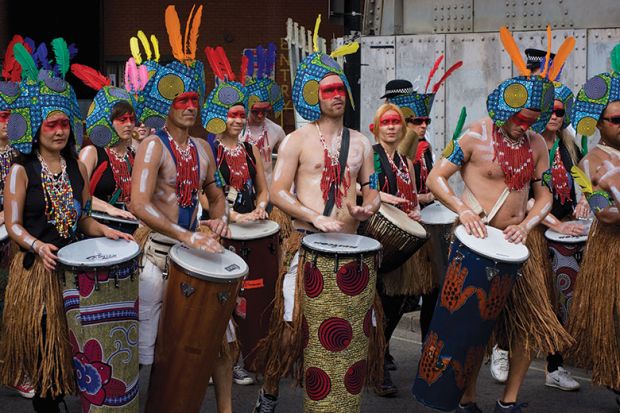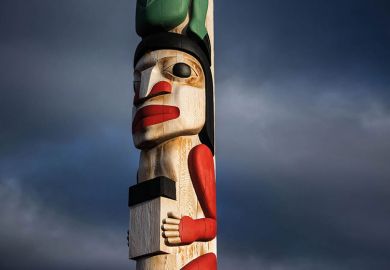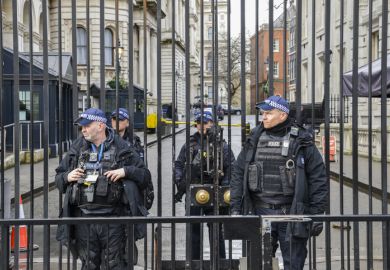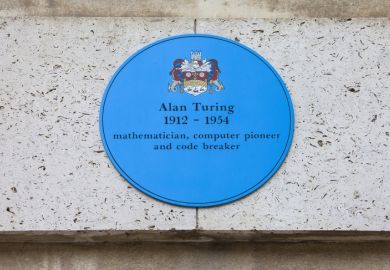The Garden of England might sound like a rather strange place to set up a new Centre for Indigenous and Settler Colonial Studies. Yet here, at the University of Kent, can be found the first such centre of its kind in Europe.
Its director, David Stirrup, professor of American literature and Indigenous studies, has a long-standing interest in Native American art and literature. His main current research project, titled “Beyond the Spectacle”, considers the experience of Native North Americans in Britain. Although the majority of Native Americans who came to Britain were short-term visitors, he said, there were also “tiny communities left behind by the movement of Buffalo Bill’s entourage” and soldiers who stayed on after fighting in Allied armies during both world wars. In addition, Professor Stirrup has created walking tours for exploring “Native American sites” – such as the spot on the River Avon where the Inuit captive Kalicho once demonstrated his duck-hunting techniques – in several English cities.
Such projects are devoted to an unusual byway of British social and racial history which it is natural to study in the UK. But while it is obvious why Indigenous studies have gained a firm footing in Australia, Canada and New Zealand, it might be less clear why we need a big multidisciplinary centre for them in Kent.
Professor Stirrup argued that there were a number of good reasons. Although Britain was “quite remote” for many Indigenous communities and scholars, it “couldn’t be avoided”, since it was also responsible for much of “the damage colonialism wrought on them”. Bringing together documentation often only accessible in the UK with Indigenous sources could prove very fruitful, for example in “tracking diasporic movements of communities”.
At the Six Nations reserve in Ontario, Professor Stirrup explained, “they have very clear records [from the time of the First World War] about those who leave the reserve to join the Canadian Army in very significant numbers. But then the trail runs cold. We can complete the picture by picking up their stories as they arrive in the UK en route to France.”
In order to make relevant material more accessible to Indigenous scholars, Professor Stirrup went on, the centre had “started a directory of North American holdings in local and regional museums, which are often off the beaten track but contain some very interesting objects. We’ve started with the south east and are developing from there.” There was also “a lot of documentation [about early American history] in places such as the National Archives that has not yet been digitised and isn’t necessarily searchable”. The centre could help “identify holdings that are a priority to be digitised” for those interested in Indigenous history and culture.
There were further intellectual and political benefits, as Professor Stirrup saw it, in a form of dialogue that involved “using the imperial sources but reading them against what the Indigenous people themselves say, whether in early written and pictorial sources or in stories that come down through oral history”. This theme will be examined in the centre’s inaugural conference in May, titled “Entangled Modernities: New Directions in Settler Colonial and Critical Indigenous Studies”, where they will be “drawing out the stories where Indigenous people are not merely the subjects of empire or a peripheral story but play an active role in developing institutions, knowledge, ways of understanding relationships and community”.
It was now widely accepted that “the governance system of the Iroquois had a direct influence on the constitution of the United States”, but Kent researchers also hope to illuminate other cases where “Indigenous people are just seen as victims of the imperialist onslaught” but had in fact played an active role in negotiating their future, Professor Stirrup said.
As of now, the researchers linked to the Centre for Indigenous and Settler Colonial Studies have wide-ranging expertise right across the social sciences and humanities (although only one is of Indigenous heritage). Debates around “decolonising cultural collections”, according to Professor Stirrup, were attracting much student interest. While building closer links with Indigenous scholars on the other side of the world was important for such scholars, it would also allow the centre to “provide more focused and structured training to people who generally have no access to Indigenous scholars and languages and communities’ knowledge repositories”, perhaps through “short-term exchanges, participation in language programmes and community-centred training”.
Even today, Professor Stirrup reported “a lot of interest in my undergraduate classes in Indigenous literatures. I hope we can provide training options that will remove some of the obstacles to taking that interest to a more serious research level.”
POSTSCRIPT:
Print headline: Kent’s Indigenous centre brings marginal stories back into history
Register to continue
Why register?
- Registration is free and only takes a moment
- Once registered, you can read 3 articles a month
- Sign up for our newsletter
Subscribe
Or subscribe for unlimited access to:
- Unlimited access to news, views, insights & reviews
- Digital editions
- Digital access to THE’s university and college rankings analysis
Already registered or a current subscriber? Login








